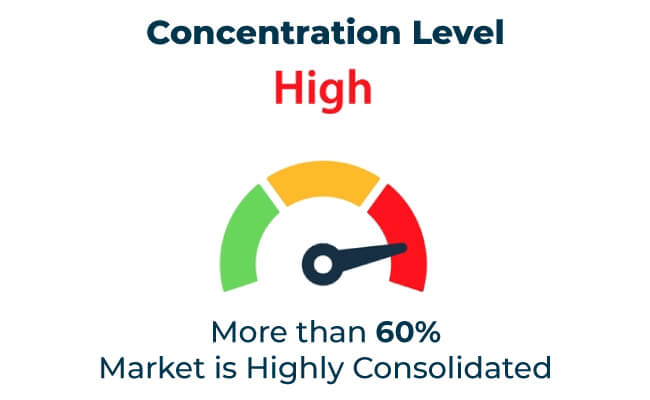Prominent Brands like BASF, DSM, and Ashland lead the blue light protection ingredient market by introducing advanced formulations designed to protect the skin from the harmful effects of digital and environmental exposure. These companies capitalize on growing awareness of blue light’s impact on skin health, integrating ingredients like niacinamide, carotenoids, and zinc oxide into their solutions.
The market, projected to grow at a CAGR of 8.6% to USD 2,051 million by 2035, benefits from rising consumer demand for multifunctional skincare. Brands collaborating with beauty and cosmetic brands to incorporate blue light protection in products such as sunscreens, serums, and foundations gain a competitive edge. Clean-label formulations and sustainable sourcing practices further strengthen their market presence.
| Attribute | Details |
|---|---|
| Projected Value by 2035 | USD 2,051 million |
| CAGR during the period 2025 to 2035 | 8.6% |
E-commerce platforms and educational campaigns drive product adoption, with Brands emphasizing the long-term benefits of blue light protection. Partnerships with dermatologists and wellness advocates enhance brand credibility, while regulatory compliance ensures market sustainability.
Differentiation comes from ingredient efficacy, transparency, and multi functionality, such as combining blue light protection with anti-aging and hydration benefits. Companies investing in clinical research and aligning with premium skincare brands will dominate this innovative segment. As digital screen usage continues to rise globally, the blue light protection ingredient market is set for robust growth.
The blue light protection ingredient market is expanding as consumers prioritize skincare solutions that mitigate damage from digital exposure. With the increasing prevalence of remote work, screen time, and consumer awareness about HEV light risks, the market has seen robust demand for protective skincare products infused with blue light blocking agents.
Global Brand Share & Industry Share (%):
| Category | Industry Share (%) |
|---|---|
| Top 3 (BASF, DSM, Ashland) | 32% |
| Rest of Top 5 (Croda, Clariant) | 22% |
| Next 5 of Top 10 (Symrise, Kobo Products, others) | 18% |
Type of Player & Industry Share (%):
| Type of Player | Industry Share (%) |
|---|---|
| Top 10 | 72% |
| Top 20 | 20% |
| Rest | 8% |

Advanced Ingredient Formulations
Encapsulation Technology
AI-Powered R&D
Eco-Friendly Sourcing
Biodegradable Ingredients
Carbon-Neutral Production
Demand for Multi-Functional Products
Focus on Digital Well-Being
Clean Beauty Movement
Regional Compliance
Export Opportunities
Invest in Education:
Prioritize Sustainability:
Enhance Multi-Functionality:
Revenue and Share by Brand
Market leaders like BASF, DSM, and Ashland maintain dominance through innovation, scalability, and strong distribution networks.
Figures/Visuals
| Brand | BASF |
|---|---|
| Market Contribution (%) | 15% |
| Key Initiatives | Focused on advanced, multi-functional protection ingredients |
| Brand | DSM |
|---|---|
| Market Contribution (%) | 13% |
| Key Initiatives | Expanded natural ingredient offerings for clean beauty |
| Brand | Ashland |
|---|---|
| Market Contribution (%) | 12% |
| Key Initiatives | Developed sustainable, plant-based blue light filters |
Scope of Market Definition
The blue light protection ingredient market includes active compounds used in skincare and cosmetic products to mitigate the harmful effects of blue light exposure. This analysis excludes general sunscreen ingredients and unrelated skincare compounds.
Key Terms and Terminology
The primary research involved a combination of primary interviews, secondary data analysis, and industry-specific modelling. The data was cross-validated with market experts and industry stakeholders to validate the accuracy and relevance of the data.
The global blue light protection ingredient market will grow at a CAGR of 8.6% between 2025 and 2035.
The global blue light protection ingredient market will reach USD 2,051 million by 2035.
The top 10 players account for over 62% of the global market.
Key manufacturers include Symrise, Kobo Products, BASF, DSM, and Ashland among others.






Full Research Suite comprises of:
Market outlook & trends analysis
Interviews & case studies
Strategic recommendations
Vendor profiles & capabilities analysis
5-year forecasts
8 regions and 60+ country-level data splits
Market segment data splits
12 months of continuous data updates
DELIVERED AS:
PDF EXCEL ONLINE
Blue Ceramic Abrasive Market Size and Share Forecast Outlook 2025 to 2035
Blueberry Extract Antioxidants Market Size and Share Forecast Outlook 2025 to 2035
Bluetooth Photo Capture Device Market Size and Share Forecast Outlook 2025 to 2035
Blue Hydrogen Market Size and Share Forecast Outlook 2025 to 2035
Bluetooth Hearing Aids Market Trends – Growth & Forecast 2025 to 2035
Bluetooth Low Energy Market Analysis by Technology, Application and Region Through 2035
Blueberries Market Analysis – Size, Share & Forecast 2025-2035
Bluetooth Adapter Market
Market Share Insights for Blueberry Ingredient Providers
Blue Light Blocking Glasses Market Size and Share Forecast Outlook 2025 to 2035
Analyzing Blue Light Blocking Glasses Market Share & Industry Leaders
Blue Light Protection Skincare Market Size and Share Forecast Outlook 2025 to 2035
Blue Light Protection Ingredient Market Trends – Growth & Forecast 2024-2034
Food Blue 5 Market Size and Share Forecast Outlook 2025 to 2035
Brilliant Blue FCF Colors Market Size and Share Forecast Outlook 2025 to 2035
Competitive Overview of Brilliant Blue FCF Colors Market Share
Industrial Bluetooth Market Size and Share Forecast Outlook 2025 to 2035
iBeacon and Bluetooth Beacon Market Outlook 2025 to 2035 by Component, Technology Platform, End Use, and Region
UK Brilliant Blue FCF Colors Market Analysis – Growth, Applications & Outlook 2025-2035
USA Brilliant Blue FCF Colors Market Report – Demand, Trends & Industry Forecast 2025-2035

Thank you!
You will receive an email from our Business Development Manager. Please be sure to check your SPAM/JUNK folder too.
Chat With
MaRIA